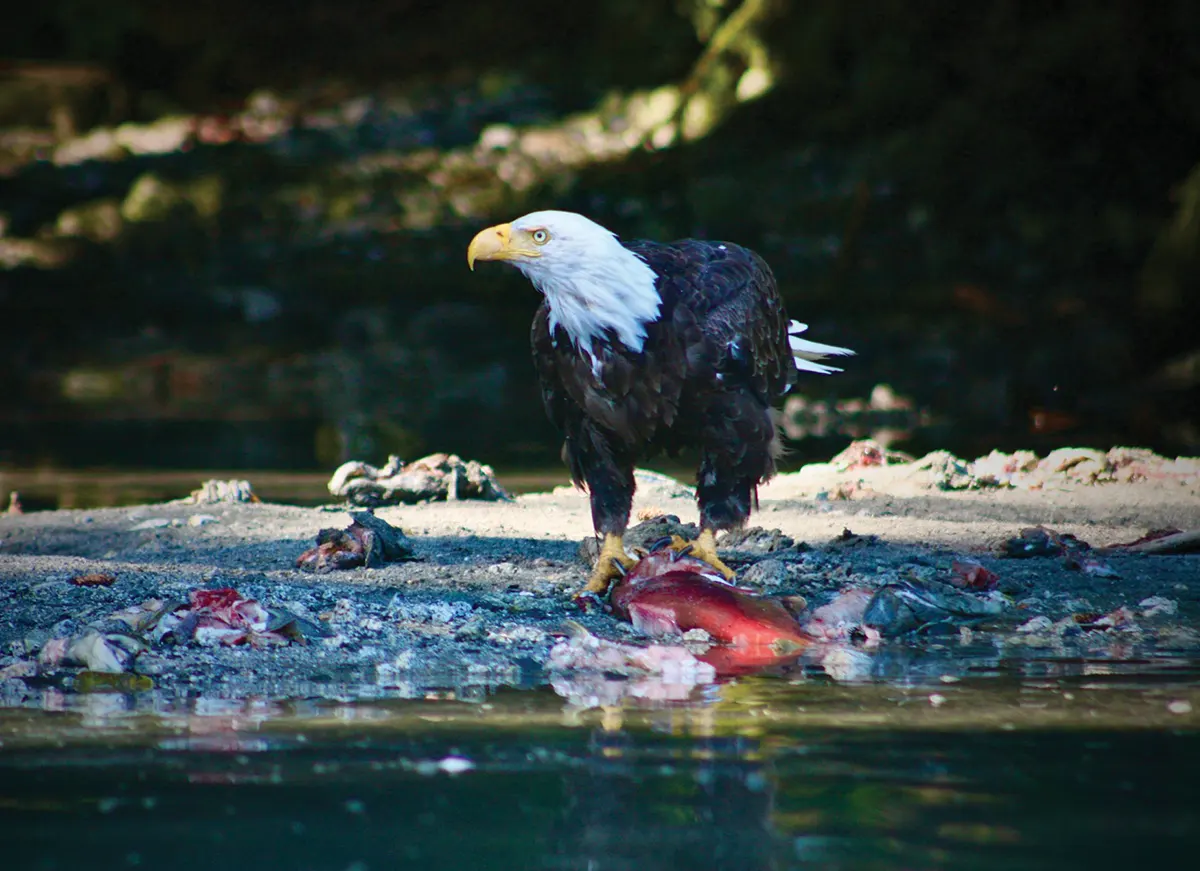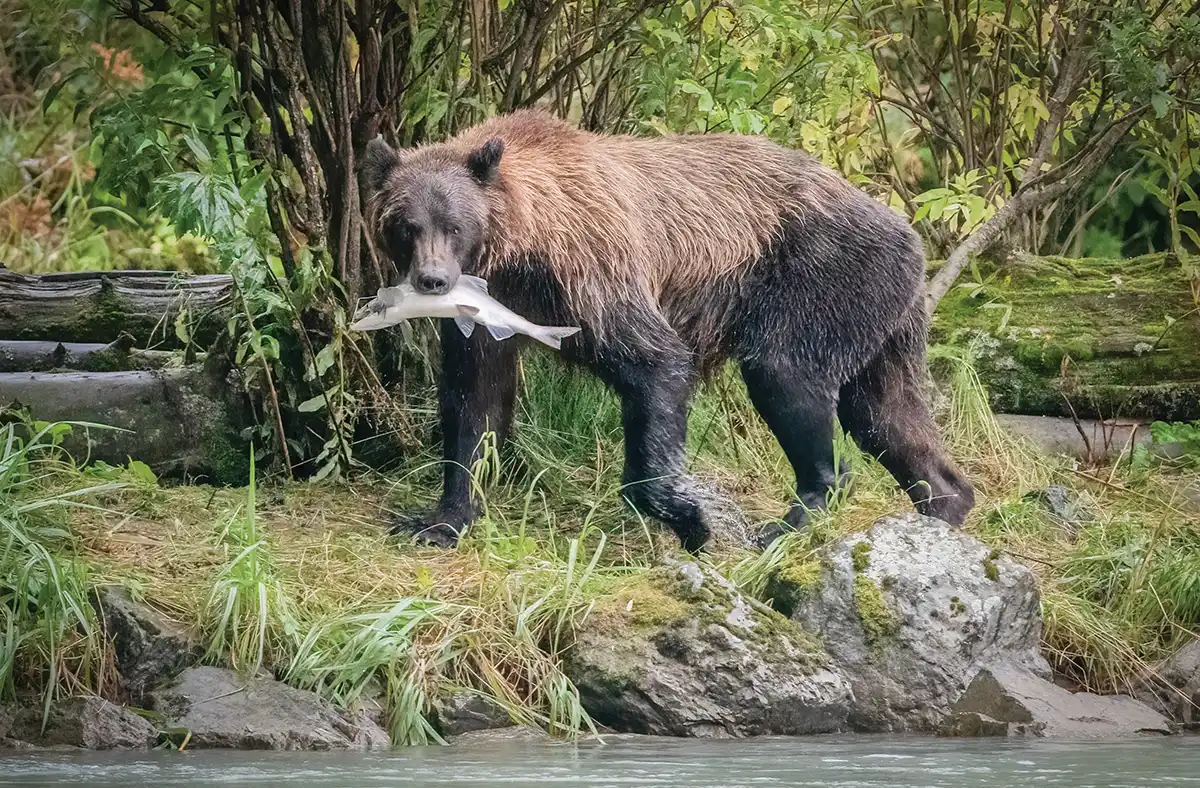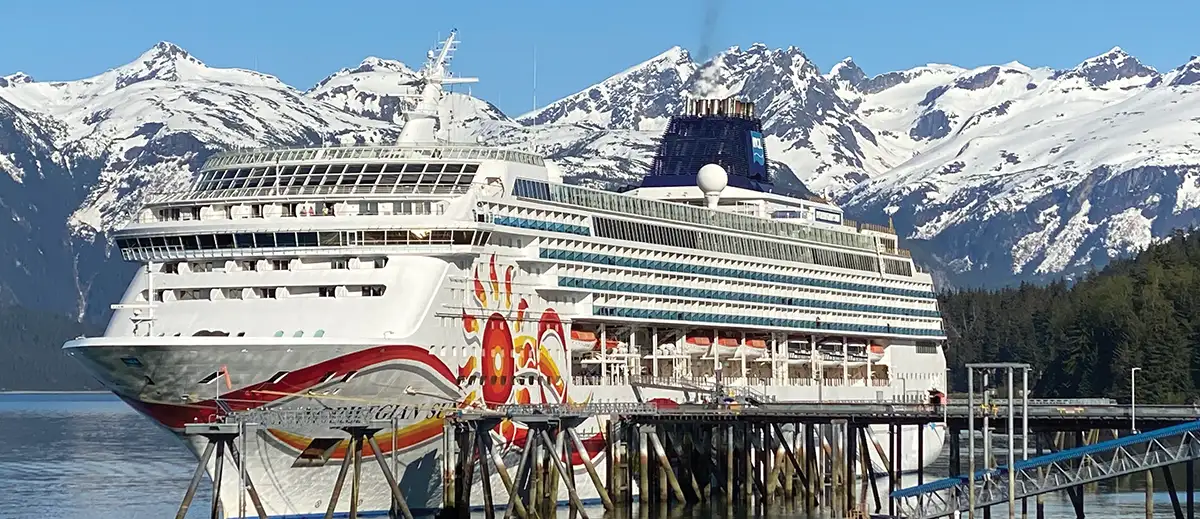ust as mist and fog roll over the coastal mountains, and just as salty waters lap along the sandy shorelines of Southeast, a new wave of opportunity is rippling across the region’s communities. They have taken bold steps in recent years and committed notable investments to embrace the cruise ship industry by developing new docks and infrastructure. This shift marks a significant turning point for these communities, many of which are working to reinvent their economies in the face of declining traditional industries like fishing and timber.
A port call by large cruise ships is more than just an economic boost—it’s a chance to share unique cultures, histories, and ways of life with the world.
“Alaska is a must-see destination for many travelers and has proven to offer the most profitable itineraries for cruise lines,” says Russell Dick, president and CEO of Huna Totem Corporation. “This presents our state with an incredible opportunity to showcase the many cultures and expansive beauty of Alaska. While a few Alaska ports are well-known and expected stops for visitors to our state, we have repeat visitors who want to see new destinations and have deeper, more meaningful experiences.”
With lush landscapes, rich wildlife, and vibrant Indigenous heritage, many Southeast Alaska communities are positioning themselves as new destinations in Alaska’s thriving tourism sector.
“We know there is a need to relieve the pressure from destinations that are at max capacity,” Dick says. “Port Klawock is perfectly situated to do just this.”
On the west side of Prince of Wales Island, Klawock offers a different vista, and cruise ship tourism offers a different avenue of prosperity. Historically dependent on the timber and fishing industries, Klawock has faced significant economic challenges in recent years. But thanks to a new partnership between Alaska Native corporations and cruise lines, Klawock is on the cusp of an economic revival.
Klawock Heenya Corporation sought the expertise of Huna Totem and Doyon, Limited, the regional corporation for the Interior that perfected its tourism game at Denali National Park and Preserve. The result of the collaboration is Port Klawock, a tender port just outside of the village. The first large cruise ships docked there this summer and sent passengers ashore.
Reba H.

“Huna Totem and our partners are not traditional for-profit companies; we have a triple-bottom line with a responsibility to ensure our shareholders and communities thrive socially, culturally, and economically,” Dick says. “Port Klawock creates jobs and entrepreneurial opportunities for locals while providing a platform to share their Tlingit culture and heritage with visitors. This is an exceptional opportunity to foster a sense of cultural pride in our younger generations.”
The port’s development began in May 2022. A floating tender dock was fabricated in Washington, towed north, and installed this spring.
“There was a good deal of earthmoving and landscaping involved, as well, so that we were able to erect our welcome facility at the site,” Dick says. “There is a reliable ecosystem of contractors and suppliers on Prince of Wales that helped move the project along, whether in large contracts or small jobs.”
The joint venture between Huna Totem and Doyon is called Na-Dena’. Dick says the collaborative effort will lean on the corporations’ collective proven success in sustainable tourism in the development of the destination.
Groups had access to paddling and kayaking adventures in local waters, where they learned about wildlife and the importance of fish to Southeast culture and lifestyles. A wildlife marine tour on a purpose-built boat helped travelers explore local ecosystems, offering close encounters with humpback whales, sea otters, and other marine wildlife. A complimentary shuttle delivered tourists to Klawock and the neighboring town of Craig, about 5 miles away, for shopping and additional cultural experiences.
One particularly popular tour, the “Taste of Klawock,” allowed visitors to sample local delicacies while learning about the history and significance of totem poles in Tlingit culture, led by knowledgeable local guides.
For the people of Klawock, the arrival of the first cruise ship was a momentous occasion. The community held a ceremony to honor the event, featuring traditional Tlingit dances and speeches. A local teacher taught the crowd the Tlingit word for “thank you”—Gunalchéesh—as the village warmly welcomed the ship’s passengers ashore.

Top and middle photo: Reba H.
Bottom photo: T Ganner | Haines Borough


According to Renée Limoge Reeve, vice president of government and community relations for Cruise Lines International Association (CLIA) in Alaska, the state has become one of the most popular cruise destinations in the world. Alaska represents 5.7 percent of the global cruise market, and visitors are drawn to the state’s breathtaking natural landscapes, unique wildlife, and immersive cultural experiences.
“The cruise industry continues to be a bright spot in Alaska’s economy, contributing significantly to the state’s overall tourism sector,” Reeve says. “Tourism creates 48,000 jobs across the state, and cruise is a major contributor to that. For many Southeast communities, cruise tourism has become a vital part of their economic recovery and growth, especially after the pandemic.”
In Haines, tourism accounts for around 20 percent of the local economy. Rebecca Hylton, tourism director for the Haines Borough, has worked closely with local officials to ensure that Haines can continue to benefit from cruise traffic while maintaining the community’s environmental and cultural values.
“Our goal is to grow our tourism sector in a sustainable way that protects the very qualities that make Haines special—our subsistence lifestyle, stunning natural beauty, and diverse wildlife,” Hylton says. “We need to be proactive in our relationship with the cruise industry to ensure that we maintain reliable cruise traffic while also preserving the quality of life for our residents.”
The borough is currently considering the development of a floating dock to improve accessibility for small and mid-sized cruise ships, which often face difficulties due to tidal fluctuations.
“Our current infrastructure presents challenges for small and mid-sized ships, which are our ideal market,” Hylton says. “These vessels often have to tender passengers even when tied to the dock, or due to tidal fluctuations may choose to tender instead of docking. This can diminish the guest experience and discourage passengers from disembarking.”
A floating dock installation in Haines would not increase the size of ships berthing there; rather, it would provide for a smoother and more efficient docking experience for the ship crews and passengers alike. The vessels that call on Haines are less than 1,000 feet in length, which keeps daily visitor numbers manageable, Hylton says.

The Haines Borough Assembly is considering a recommended $9 per head port fee that would help partially fund the floating dock. The proposal has received unanimous Assembly support, with one public hearing completed, and finalization anticipated this fall. Officials are also actively seeking additional resources to assist with funding this project, Hylton says.
Both the Haines Ports and Harbor Advisory Committee and the Tourism Advisory Board have reviewed three concept designs for a floating dock. Although they have yet to make formal recommendations to the Borough Assembly, the borough has already allocated $100,000 in the current fiscal year for design purposes.
“I will be working diligently to bring this matter before the Assembly, as I believe the floating dock component is crucial for our community’s future,” Hylton says.
Hylton adds that a proactive relationship with the cruise industry is essential. “While Haines may not be a large or busy port like Juneau or Skagway, that does not mean we should take a passive approach. As a community, we need to take an active role in shaping the future of tourism in Haines, ensuring that it aligns with our values and priorities,” she says. “My goal is to establish a balance where Haines can maintain reliable cruise traffic, providing consistent foot traffic for our local business owners and entrepreneurs, while preserving the quality of life and the authentic Alaskan experience that make Haines unique.”
Skagway, for example, is repairing a damaged cruise dock float as part of its larger Ore Dock redevelopment project, while Juneau has replaced its fleet of buses with more environmentally friendly double-decker models to reduce traffic congestion and emissions.
Ports of call must balance these welcoming moves with local concerns about over-tourism and the environmental impact of large cruise ships. Reeve says CLIA and its member cruise lines work proudly alongside Southeast communities that deal with these issues.
“Our three Memorandums of Agreement with the City and Borough of Juneau are examples of the industry being responsive to the needs of individual towns,” she says. “We know that in addition to the economic benefits cruise contributes, there are always opportunities to collaborate with communities, and CLIA is here to help ensure the best experience for residents and visitors alike.”
For communities like Klawock and Haines, the focus remains on sustainable growth. By embracing the cruise industry and sharing their rich cultural heritage with the world, these towns are securing their economic future and ensuring that their traditions are preserved for generations to come.
As Southeast continues to develop its cruise ship infrastructure, the region is one of the most sought-after destinations for travelers seeking immersive, culturally rich experiences. Visiting these unique and remote destinations via ship would be a difficult and very expensive experience to replicate with land travel, Reeve says.
Whether it’s the chance to witness traditional Tlingit dances in Klawock, explore the rugged wilderness of Haines, or experience the stunning glaciers and wildlife of the Inside Passage, cruise visitors are discovering that Southeast Alaska has much more to offer than meets the eye.
And as these communities open their arms to the world, they are proving that economic growth and cultural preservation can go hand in hand—ensuring a bright future for the people of Alaska.
“Alaska Native organizations need to own and lead the development of cultural tourism opportunities for them to be authentic,” Dick says. “These are our stories to tell, and we intend to continue building this network across Alaska and beyond.”